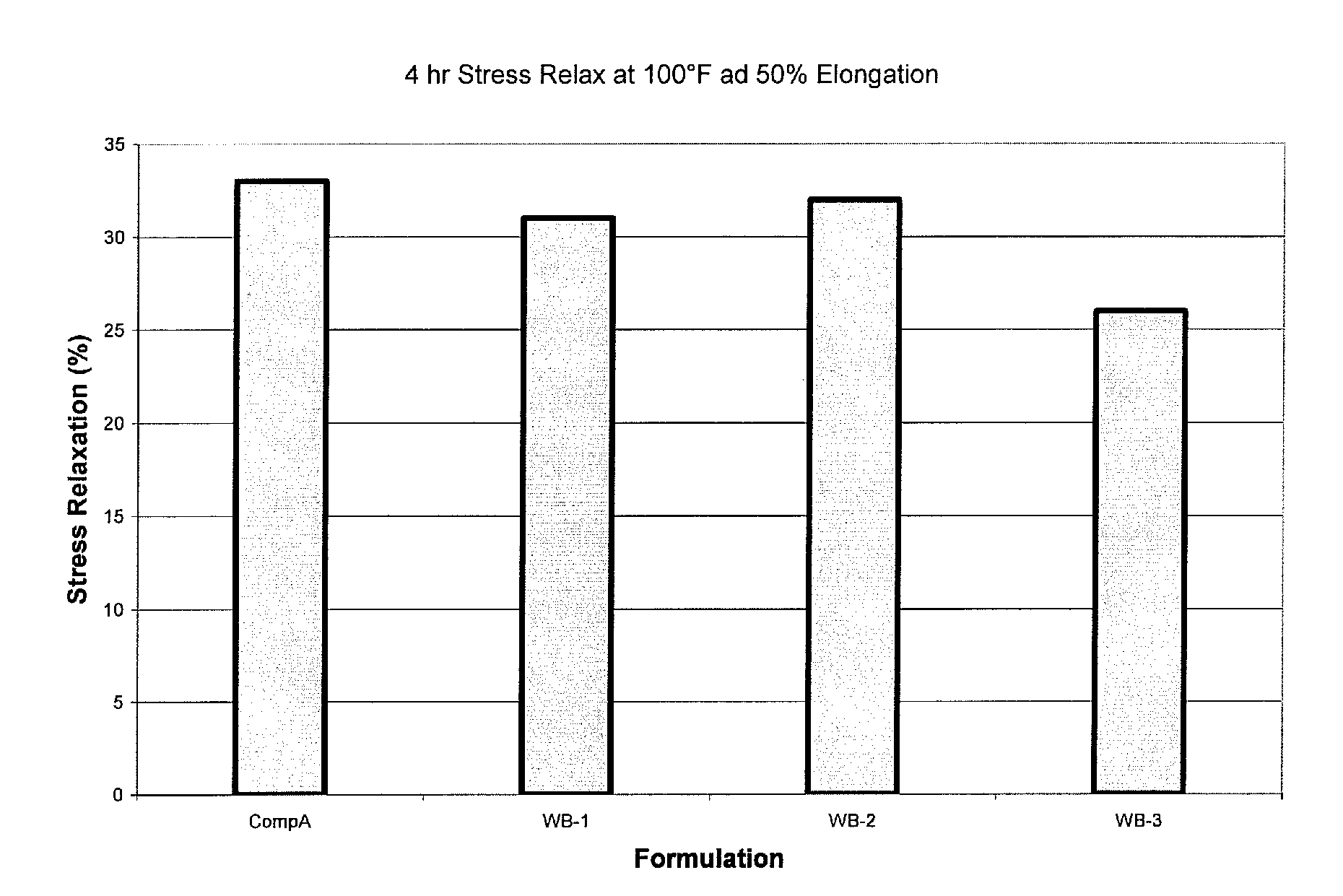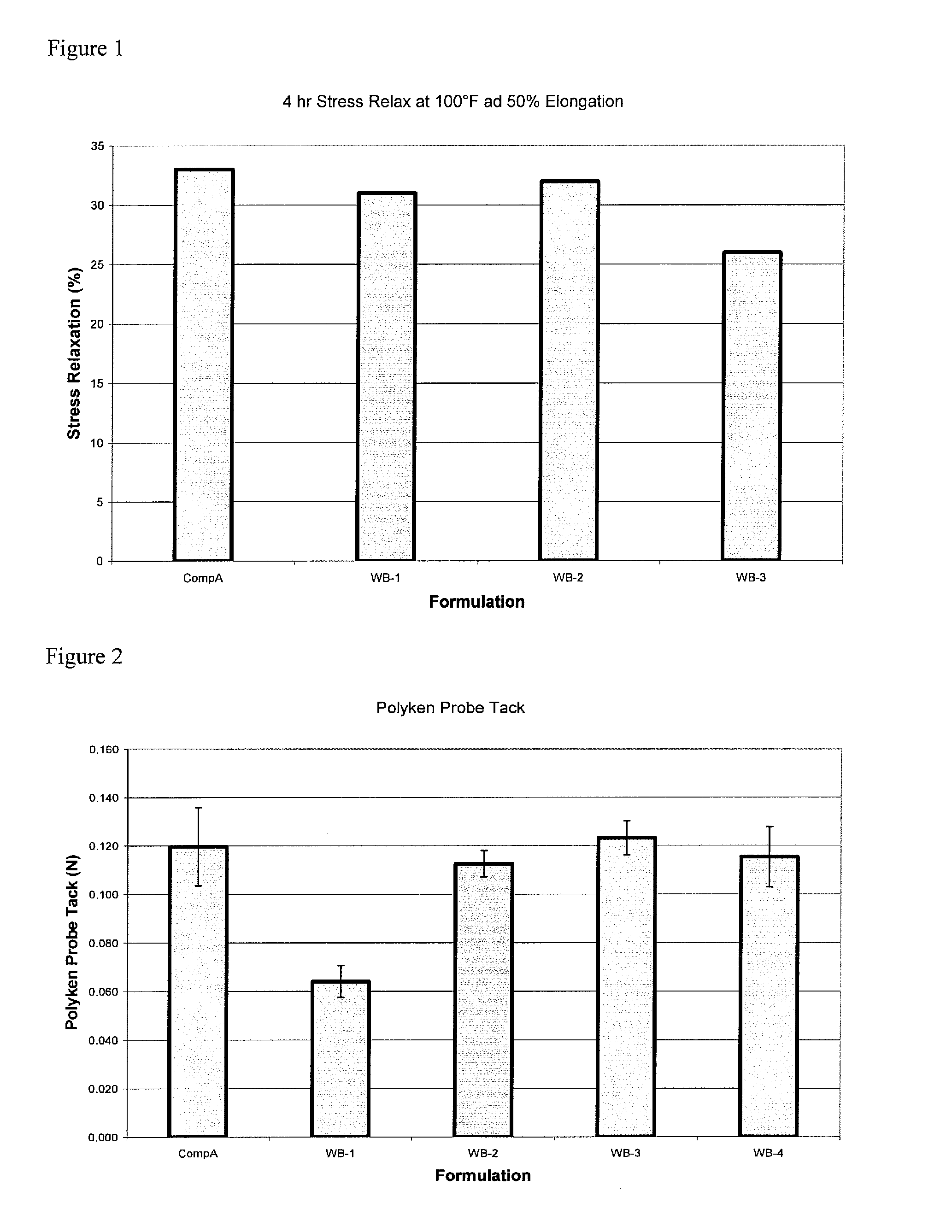High Tensile Strength Article with Elastomeric Layer
a technology of elastomeric layer applied in the field of articles, can solve the problems of the most expensive components of elastic laminates, and achieve the effects of low stiffness, good balance, and high tensile strength
- Summary
- Abstract
- Description
- Claims
- Application Information
AI Technical Summary
Benefits of technology
Problems solved by technology
Method used
Image
Examples
example 1
[0030]The formulation ingredients for Comparative A, WB-1, WB-2, WB-3, and WB-4 were dry blended. The material was manufactured on a 40 mm twin screw extruder. The material was processed with a temperature profile of 360-460 degrees Fahrenheit, at a screw speed of 300 rpm, generating a melt temperature ranging from 420-450° F. The manufactured product was converted to a 3 mil thick, 6 inch square film using a single screw extruder with a temperature profile of 390-450° F., at a screw speed of 34 rpm, generating a melt temperature of 447° F. The resulting elastic films were collected on a chill roll set to 41° F.
[0031]The compositions are set forth in Table 1. Polymer 1 is a coupled, hydrogenated styrene-ethylene / butadiene-styrene thermoplastic block copolymer with 19% styrene content and total molecular weight of 71,000 g / mol.
Comparative AWB-1WB-2WB-3WB-4Ingredientwt %wt %wt %wt %wt %Polymer 1 68% 68% 68% 68% 68%Epolene C-1011.71% 11.71% 11.71% Affinity GA190011.71% 11.71% Regalrez ...
example 2
[0034]In addition to high tensile strength and good elasticity as described in Example 1, many applications also require a high level of tack to enhance adhesion of the an elastic laminate where layers or components in the elastic film or filaments of the present invention are laminated in physical contact with a polyolefin nonwoven. Surface tack has been measured via Polyken Probe Tack Testing according to ASTM D2979. The Polyken probe tack test measures the maximum force it takes to break the bond between a metal probe and an adhesive surface under controlled conditions. In this example, Polyken probe tack testing was measured using the following procedure:[0035]Place the angular ring over a 2″×2″ film sample. After engaging the test apparatus, the test platform moves downward and maintains probe contact with the sample for a dwell time of 1 second. The test platform moves upward and the load cell will measure the peak tension force on the probe during the upward movement. Formula...
example 3
[0036]The formulation ingredients were dry blended. The material was manufactured on a 40 mm twin screw extruder. The material was processed with a temperature profile of 410-460 degrees Fahrenheit, at a screw speed of 300 rpm, generating a melt temperature of 454° F. The manufactured product was converted to a 3 mil thick, 6 inch wide film using a single screw extruder with a temperature profile of 380-450° F., at a screw speed of 34 rpm generating a melt temperature of 447° F. The resulting elastic films were collected on a chill roll set to 41° F.
FormulationKIC-09-012Kraton A 153667.50%Arkon P1259.00%Arlon P1409.00%Affinty GA19004.25%EA3400 PS10.00%Ethanox 3300.15%Irgafos 1680.15%
[0037]This example demonstrates the specific combination of a selectively hydrogenated controlled distribution block copolymer (Kraton A1536) with cyclic aliphatic tackifying resins, a polyolefin plastomer and polystyrene. The final result is an elastic article demonstrating unexpectedly high tensile str...
PUM
| Property | Measurement | Unit |
|---|---|---|
| tensile strength | aaaaa | aaaaa |
| elongation | aaaaa | aaaaa |
| elongation | aaaaa | aaaaa |
Abstract
Description
Claims
Application Information
 Login to View More
Login to View More - R&D
- Intellectual Property
- Life Sciences
- Materials
- Tech Scout
- Unparalleled Data Quality
- Higher Quality Content
- 60% Fewer Hallucinations
Browse by: Latest US Patents, China's latest patents, Technical Efficacy Thesaurus, Application Domain, Technology Topic, Popular Technical Reports.
© 2025 PatSnap. All rights reserved.Legal|Privacy policy|Modern Slavery Act Transparency Statement|Sitemap|About US| Contact US: help@patsnap.com


